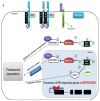The brassinosteroid signaling pathway-new key players and interconnections with other signaling networks crucial for plant development and stress tolerance
- PMID: 23615468
- PMCID: PMC3676754
- DOI: 10.3390/ijms14058740
The brassinosteroid signaling pathway-new key players and interconnections with other signaling networks crucial for plant development and stress tolerance
Abstract
Brassinosteroids (BRs) are a class of steroid hormones regulating a wide range of physiological processes during the plant life cycle from seed development to the modulation of flowering and senescence. The last decades, and recent years in particular, have witnessed a significant advance in the elucidation of the molecular mechanisms of BR signaling from perception by the transmembrane receptor complex to the regulation of transcription factors influencing expression of the target genes. Application of the new approaches shed light on the molecular functions of the key players regulating the BR signaling cascade and allowed identification of new factors. Recent studies clearly indicated that some of the components of BR signaling pathway act as multifunctional proteins involved in other signaling networks regulating diverse physiological processes, such as photomorphogenesis, cell death control, stomatal development, flowering, plant immunity to pathogens and metabolic responses to stress conditions, including salinity. Regulation of some of these processes is mediated through a crosstalk between BR signalosome and the signaling cascades of other hormones, including auxin, abscisic acid, ethylene and salicylic acid. Unravelling the complicated mechanisms of BR signaling and its interconnections with other molecular networks may be of great importance for future practical applications in agriculture.
Figures




Similar articles
-
Crosstalk of the Brassinosteroid Signalosome with Phytohormonal and Stress Signaling Components Maintains a Balance between the Processes of Growth and Stress Tolerance.Int J Mol Sci. 2018 Sep 9;19(9):2675. doi: 10.3390/ijms19092675. Int J Mol Sci. 2018. PMID: 30205610 Free PMC article. Review.
-
Benefits of brassinosteroid crosstalk.Trends Plant Sci. 2012 Oct;17(10):594-605. doi: 10.1016/j.tplants.2012.05.012. Epub 2012 Jun 26. Trends Plant Sci. 2012. PMID: 22738940 Review.
-
Crosstalk between Brassinosteroids and Other Phytohormones during Plant Development and Stress Adaptation.Plant Cell Physiol. 2024 Nov 13;65(10):1530-1543. doi: 10.1093/pcp/pcae047. Plant Cell Physiol. 2024. PMID: 38727547 Review.
-
Brassinosteroids: Multidimensional Regulators of Plant Growth, Development, and Stress Responses.Plant Cell. 2020 Feb;32(2):295-318. doi: 10.1105/tpc.19.00335. Epub 2019 Nov 27. Plant Cell. 2020. PMID: 31776234 Free PMC article. Review.
-
Brassinosteroid signaling in plant development and adaptation to stress.Development. 2019 Mar 14;146(5):dev151894. doi: 10.1242/dev.151894. Development. 2019. PMID: 30872266 Free PMC article. Review.
Cited by
-
Exploring the Brassinosteroid Signaling in Monocots Reveals Novel Components of the Pathway and Implications for Plant Breeding.Int J Mol Sci. 2020 Jan 5;21(1):354. doi: 10.3390/ijms21010354. Int J Mol Sci. 2020. PMID: 31948086 Free PMC article. Review.
-
Mycorrhiza alters the profile of root hairs in trifoliate orange.Mycorrhiza. 2016 Apr;26(3):237-47. doi: 10.1007/s00572-015-0666-z. Epub 2015 Oct 24. Mycorrhiza. 2016. PMID: 26499883
-
Identification of functionally important microRNAs from rice inflorescence at heading stage of a qDTY4.1-QTL bearing Near Isogenic Line under drought conditions.PLoS One. 2017 Oct 18;12(10):e0186382. doi: 10.1371/journal.pone.0186382. eCollection 2017. PLoS One. 2017. PMID: 29045473 Free PMC article.
-
Detection of First Marker Trait Associations for Resistance Against Sclerotinia sclerotiorum in Brassica juncea-Erucastrum cardaminoides Introgression Lines.Front Plant Sci. 2019 Aug 6;10:1015. doi: 10.3389/fpls.2019.01015. eCollection 2019. Front Plant Sci. 2019. PMID: 31447876 Free PMC article.
-
Transcriptome analysis reveals genes commonly induced by Botrytis cinerea infection, cold, drought and oxidative stresses in Arabidopsis.PLoS One. 2014 Nov 25;9(11):e113718. doi: 10.1371/journal.pone.0113718. eCollection 2014. PLoS One. 2014. PMID: 25422934 Free PMC article.
References
-
- Bajguz A., Tretyn A. The chemical characteristic and distribution of brassinosteroids in plants. Phytochemistry. 2003;62:1027–1046. - PubMed
-
- Fujioka S., Yokota T. Biosynthesis and metabolism of brassinosteroids. Annu. Rev. Plant Biol. 2003;54:137–164. - PubMed
-
- Clouse S.D., Sasse J.M. Brassinosteroids: Essential regulators of plant growth and development. Annu. Rev. Plant Physiol. Plant Mol. Biol. 1998;49:427–451. - PubMed
-
- Bajguz A. Brassinosteroids – occurence and chemical structures. In: Hayat S., Ahmad A., editors. Brassinosteroids: A Class of Plant Hormones. Springer; Dordrecht, The Netherlands: 2011. pp. 1–27.
Publication types
MeSH terms
Substances
LinkOut - more resources
Full Text Sources
Other Literature Sources

